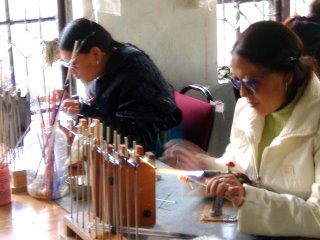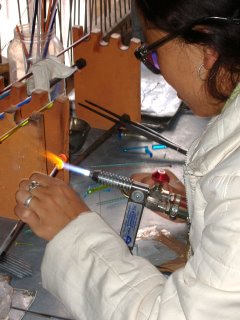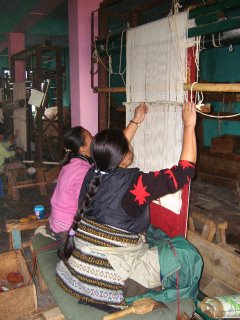Tibetan Craftswomen at Work

For the Tibetan refugee community here in India, jobs are not easy to come by, but thankfully a few business models have been extremely successful. Two that stand out above the rest are the Glass Beads Workshop and the Women's Handicraft Center, both staffed by local Tibetan Women. The quality of their craftswomanship is without peer.

I found out about the Glass Beads Workshop through its manager, Kalden, a hardy Tibetan with a big heart and brains to match. When Amy and I were camping up in the mountains, he lent us one of his tents, without which we would have been quite chilly. He also belted out some haughty Tibetan nomadic tunes, much to the enjoyment of our ears.
 When he's not leading treks into the mountains, Kalden manages the Beads Workshop, where he reads stories of Tibetan Freedom Fighters to his employees and encourages them to drink enough water (and not too much butter tea). In his spare time he organizes clean up crews and lectures his neighbors for dumping trash in the wilderness.
When he's not leading treks into the mountains, Kalden manages the Beads Workshop, where he reads stories of Tibetan Freedom Fighters to his employees and encourages them to drink enough water (and not too much butter tea). In his spare time he organizes clean up crews and lectures his neighbors for dumping trash in the wilderness.

I found out about the Glass Beads Workshop through its manager, Kalden, a hardy Tibetan with a big heart and brains to match. When Amy and I were camping up in the mountains, he lent us one of his tents, without which we would have been quite chilly. He also belted out some haughty Tibetan nomadic tunes, much to the enjoyment of our ears.
 When he's not leading treks into the mountains, Kalden manages the Beads Workshop, where he reads stories of Tibetan Freedom Fighters to his employees and encourages them to drink enough water (and not too much butter tea). In his spare time he organizes clean up crews and lectures his neighbors for dumping trash in the wilderness.
When he's not leading treks into the mountains, Kalden manages the Beads Workshop, where he reads stories of Tibetan Freedom Fighters to his employees and encourages them to drink enough water (and not too much butter tea). In his spare time he organizes clean up crews and lectures his neighbors for dumping trash in the wilderness.It felt gender-imbalanced to see a dozen women under the management of one man, but Kalden seems a fair and effective leader. The employees seem happy and motivated; their workplace is airy, clean, safe and spacious. Some women torch colored ceramic rods, melting them under intense heat to mold them into iridescent swirls. Others, on break, look after their children. The beads they create resemble some exotic ocean dweller, and fetch a hefty price to match their beauty. The women here make more money in a day than some medical professionals, though that isn't saying much; a Tibetan nurse can make as little as 60 rupees ($1.50) a day - about how much I spend on dinner.
 Elsewhere in town, The Women's Handicraft Center showcases the softest, thickest rugs ever I did see, each with matting as heavy as a Yak's shaggy bottom and colors as rich as a freshly washed monk's robe. Such luxurious comfort comes at a hefty price, but worth every rupee. I've heard such rugs can last a century without losing their luster.
Elsewhere in town, The Women's Handicraft Center showcases the softest, thickest rugs ever I did see, each with matting as heavy as a Yak's shaggy bottom and colors as rich as a freshly washed monk's robe. Such luxurious comfort comes at a hefty price, but worth every rupee. I've heard such rugs can last a century without losing their luster.
0 Comments:
Post a Comment
Subscribe to Post Comments [Atom]
<< Home